The Forgotten Olympic Exhibition: Georg Alexander Mathéy’s Contribution to the 1936 Summer Olympics in Berlin.
Posted: August 2, 2022 Filed under: Archival Research, Art History, Biography, Exhibits, History of Archaeology, Modern Greek History, Philhellenism | Tags: Georg Alexander Mathéy, Polyxene Roussopoulos Mathéy, Walter Hege 3 CommentsBY ALEXANDRA KANKELEIT
Alexandra Kankeleit is a German-Greek archaeologist and historian. She has been researching German archaeology in Greece during the Nazi period for several years. Since July 2021 she has been working for the CeMoG (Centrum Modernes Griechenland) at the Freie Universität Berlin, where she will teach a seminar on the 1936 Summer Olympics in the upcoming winter semester. Here she contributes an essay about the German artist Georg Alexander Mathéy (1884-1968), who lived in Greece in the 1930s and whose work was displayed in the Summer Olympics of 1936.
The Badische Landesbibliothek in Karlsruhe (BLB) has held a large part of the estate of painter and writer Georg Alexander Mathéy (1884-1968) since 1993. In 2017, the BLB organized an exhibition, titled Sprachbilder – Bildersprache: Die Künstler Helene Marcarover und Georg Alexander Mathéy, to showcase the works of Mathéy together with those of another artist, the painter and poet Helene Markarova (1904-1992). Both artists, whose work was shaped by the two wars, by migration and alienation, were able through literature to transform images into words, and vice versa. A wonderful accompanying publication provides insights into Mathéy’s life and creative work (Axtmann – Stello 2017).
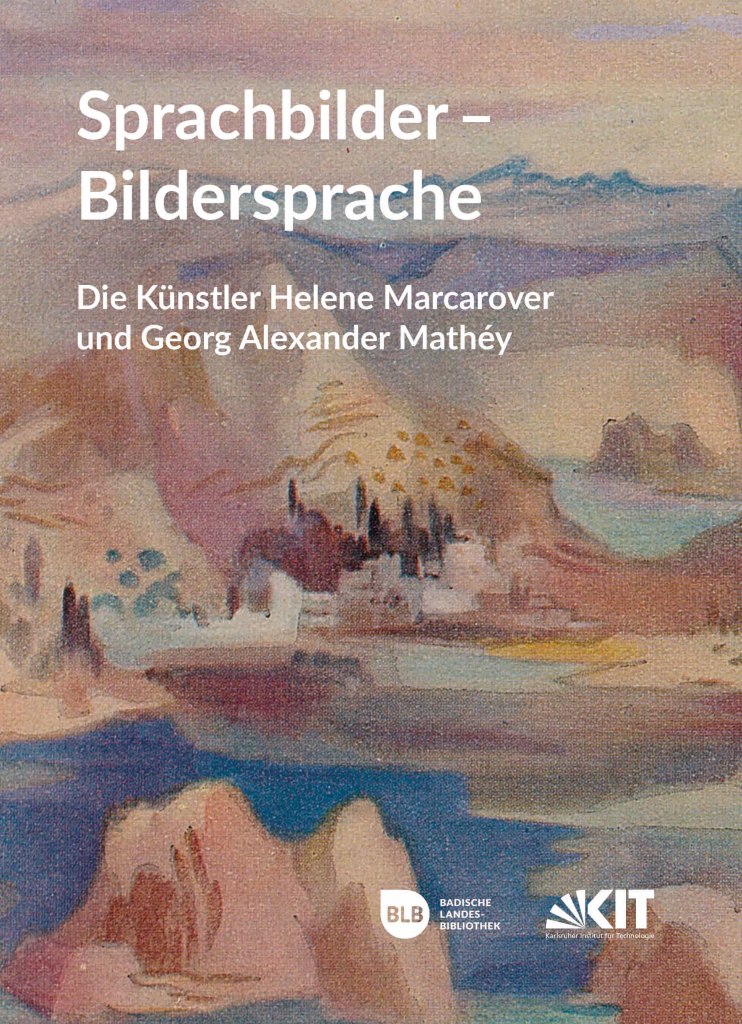
Trained as an architect in Budapest, Mathéy made his name as an illustrator of numerous books and magazines, achieving commercial success already at a young age. He also designed stamps, textiles, and a Rosenthal coffee service. Two of his stamp designs are still remembered today because of their intense colors and memorable motifs: the “bricklayer” (1919) and the “post horn” (1951). They can be described as classics of German stamp design.

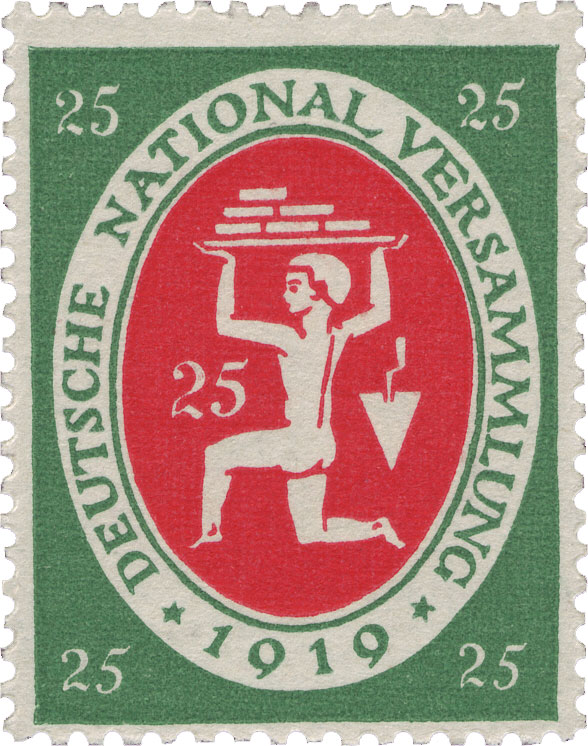
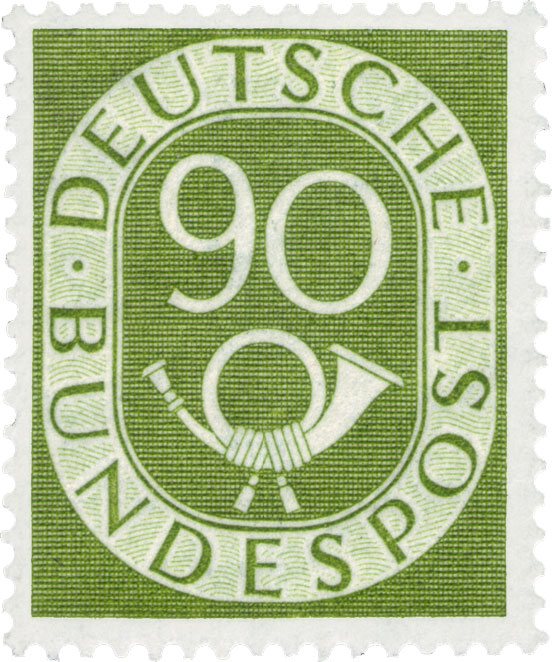
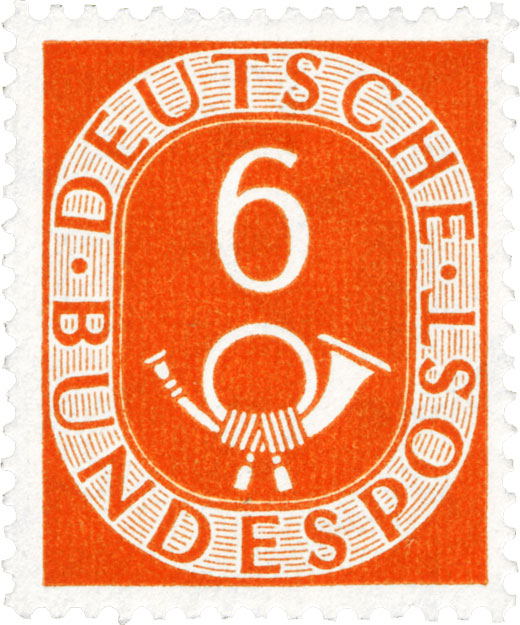
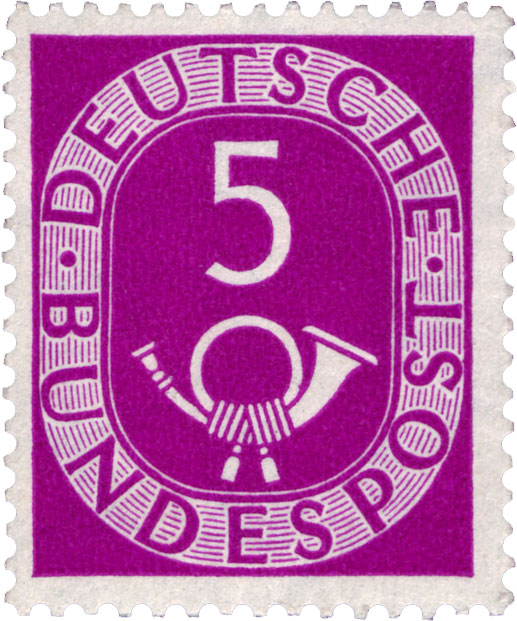
In addition to this modern, highly reductivist formal language, Mathéy also mastered other, more traditional media, primarily in his large-scale watercolors and oil paintings.
I became interested in Mathéy’s largely forgotten contribution to the 1936 Summer Olympics in Berlin. The starting point is material from the archives of the BLB, which provided new and important information about Mathéy. (I would like to thank the director of the BLB, Julia Hiller von Gaertringen, for her interest and active support in my project. A detailed German version of this article can be found on the BLBlog.) Further information can also be found in an unpublished research paper on Georg Alexander Mathéy, which the designer Ulrike Jänichen completed in 2003 under the direction of Professor Mechthild Lobisch at the Burg Giebichenstein Kunsthochschule in Halle. She kindly made her work available to me.
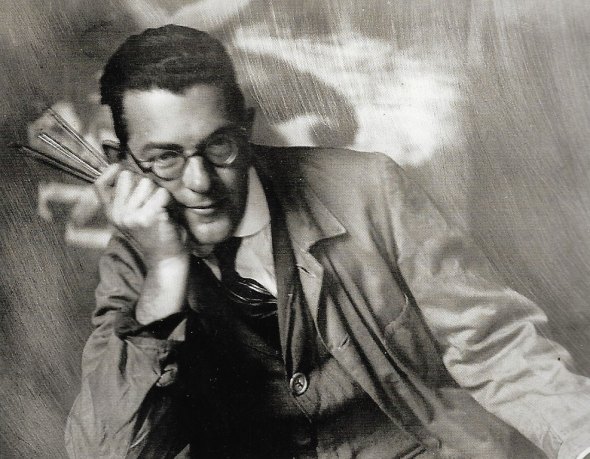
How did Mathéy come to be associated with Greece?
In 1926 Mathéy met in Leipzig his second wife, the piano soloist Polyxene Roussopoulos (1902-1999), daughter of chemist Othon Roussopoulos, who contributed to the conservation of the bronzes in the National Archaeological Museum (Moraitou 2020). Ιt was love at first sight (as claimed by their son Alexander Mathéy). Polyxene had a very close connection to Germany for family reasons. Her grandparents had lived in Leipzig for several years and German was the predominant language spoken at home. Mathéy, cosmopolitan by nature but also a Transylvanian Saxon of Greek descent (Ματθαίου) from Hermannstadt, in turn, felt a strong connection to Greece. Greek ancestry and Orthodox faith must have also played a role in his decision to move to Greece. He was not the only one. In the interwar period, several German artists who were particularly enthusiastic about the country’s landscape, culture, and extraordinary light came to Greece. These included, for example, painters Alexander Mohr and Conrad Westpfahl, and photographers Herbert List and Hermann Wagner (the last also worked in the Athenian Agora excavations).
In 1931 Georg and Polyxene moved to Greece. He was to remain there until December 1940. The Greco-Italian War, the invasion of the Wehrmacht, and the subsequent occupation of Greece from April 1941 to October 1944, ended his stay in Greece and also led to his separation from Polyxene, who did not want to leave her homeland under any circumstances.
What role did Greece play in Mathéy’s artistic work?
Mathéy’s love of Greece is evident in numerous paintings, sketches, drawings, and texts, most of which were printed in newspaper articles and books. He was well connected to the so-called German colony in Athens and was highly respected and supported by a number of influential people. These included representatives of the German legation, senior staff of the German Archaeological Institute and the German School of Athens (Deutsche Schule Athen), and several members of the German press. His pleasing, never polarizing style was obviously in demand, so he had no shortage of commissions. Light, almost floating compositions of bright, harmoniously flowing colors were characteristic of his work. His paintings from the 1930s appear serene and calming – far removed from the extreme political and social events in Germany and Greece.
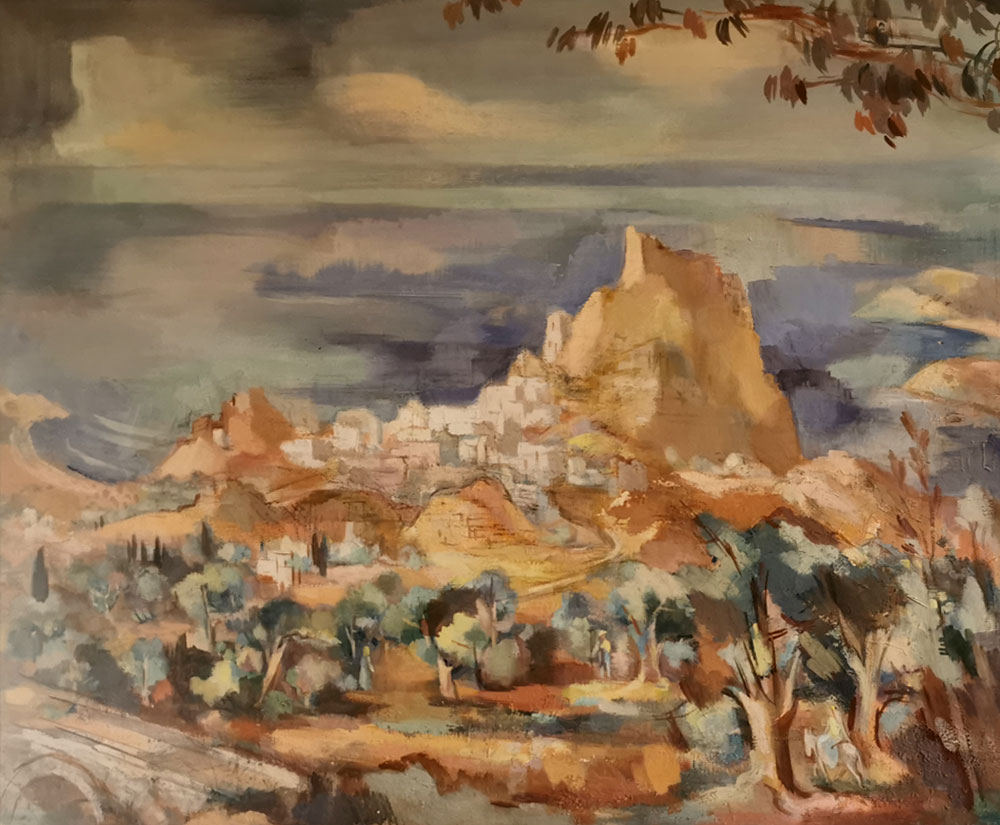
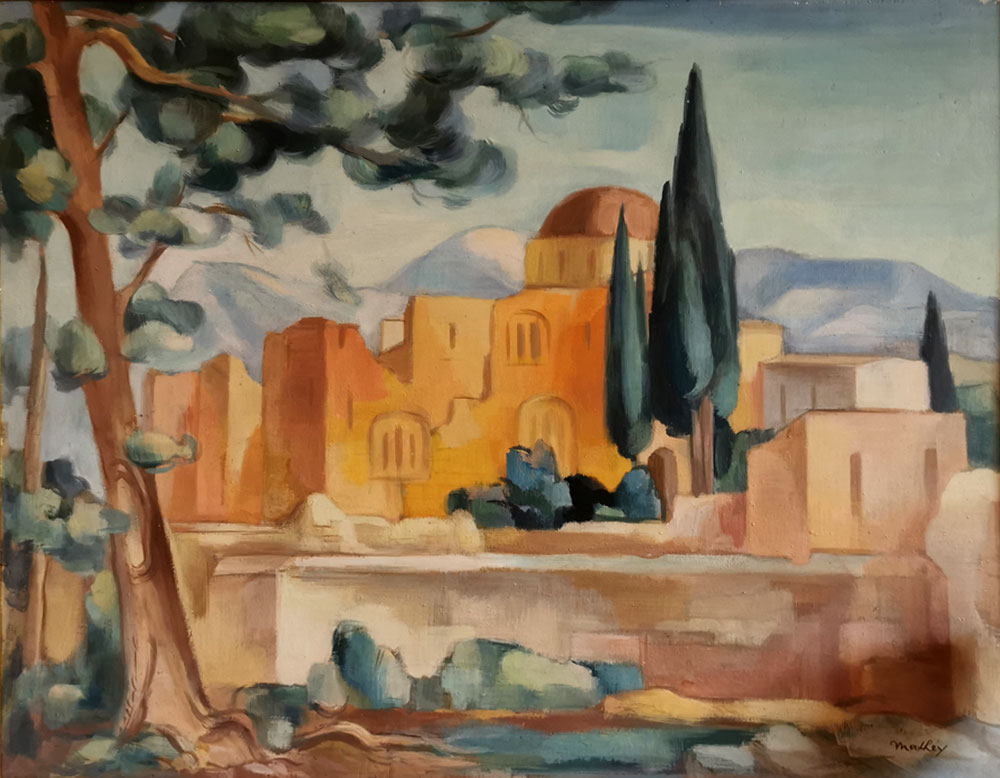
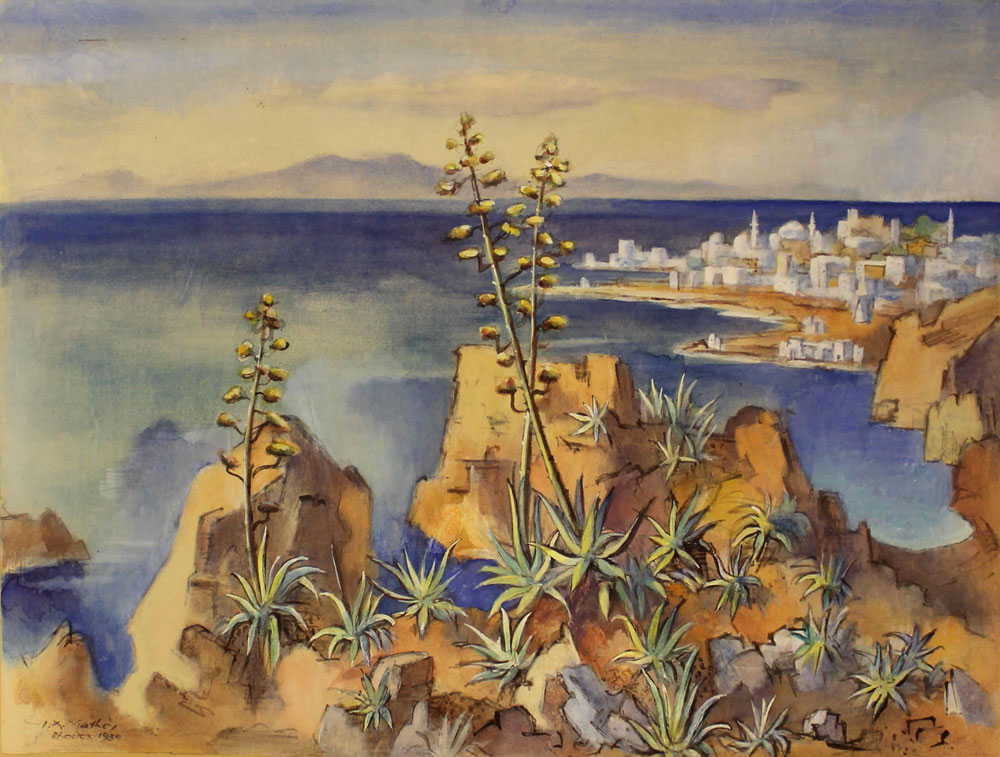
In 1933 he had the opportunity to present his work to a larger audience. Under the patronage of the representative of the German legation in Athens, Ernst Eisenlohr, and following a laudatory opening speech by the director of the German Archaeological Institute in Athens, Georg Karo, Mathéy was admitted onto the Mt. Olympus of contemporary artists in Greece (BLB, Nachlass Georg Alexander Mathéy, K3328D38,116; Reyle 1933).
In 1934, he created a monumental wall mosaic for the German Protestant Church in Athens on Sina Street, which was intended to lend a colorful accent to the subdued style of the Bauhaus building.
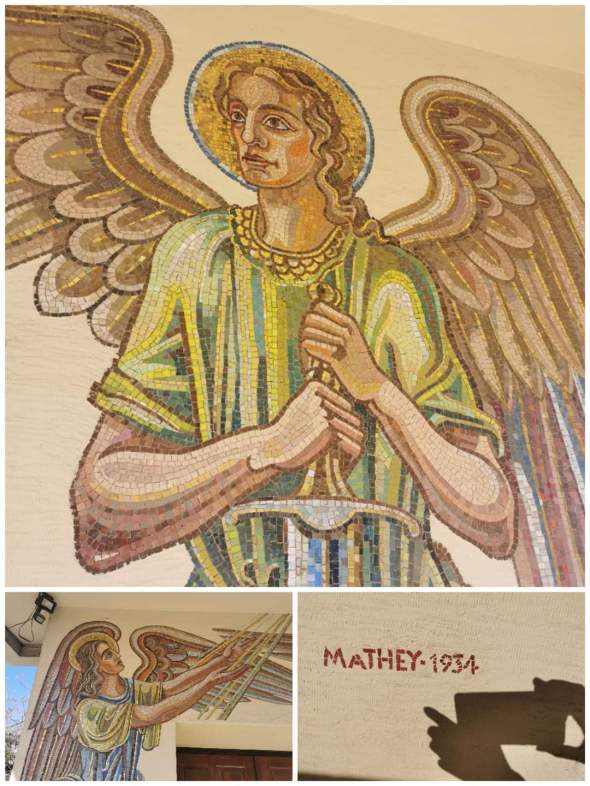
The entrance portal is framed by two angels, who serve as a reminder of an important event in German-Greek history: the heroic struggle from 1821 to 1829 by German Philhellenes for the liberation of Greece from Turkish rule (according to the editorial in the Neue Athener Zeitung of April 21, 1935).
Mathéy and the Olympics of 1936
In the run-up to the 1936 Summer Olympics, numerous actions took place in Germany to express the cultural superiority of the German Reich, its progressiveness and modernity, but also its close relationship to ancient Greece. The torch relay, as well as several exhibitions about sports in ancient and modern times, were intended to highlight Germany’s outstanding role as the “guardian of the Holy Grail of the Olympic Idea” (source: the newspaper “Stettiner General-Anzeiger” of December 31, 1934, Carl and Liselott Diem Archive of the German Sport University Cologne). The Nazi regime spared no effort or expense to set in motion a gigantic propaganda machine. During the Olympic Games themselves, from August 1 to 16, 1936, at least eight exhibitions were held in Berlin alone (Führer 1936, 59-64).
One of the most important exhibitions, titled “Sport of the Hellenes” (Sport der Hellenen), took place on the Museum Island in Berlin. It was advertised in all media and would eventually count over 100,000 visitors. Little known and so far barely studied is Mathéy’s participation in this exhibition. In 1935, he had been commissioned by Theodor Lewald, the president of the German Organizing Committee (OC) of the Olympic Games, to produce four large-scale paintings of ancient sites in Greece (BLB, Nachlass Georg Alexander Mathéy, K 3328 C 71 3 and K 3328 C 71 10). The “Greek Circle,” a series of romantic paintings of Greece by the Bavarian painter Carl Rottman (1797-1850), must have served as inspiration.
“Sport of the Hellenes”
On July 16, 1936, the exhibition “Sport of the Hellenes” was officially opened in the former German Museum, in the north wing of the Pergamon Museum (Führer 1936, 42). The catalogue and a few surviving photographs give us a glimpse of the selection and arrangement of the exhibits. Plaster casts of famous Greek sculptures were presented in the main hall of the German Museum (Lehmann 2003). These were exclusively representations of male athletes. In addition, there were smaller objects from various German museums, mainly vases, bronze figures, and marble fragments. The exhibition organizers were particularly proud of the fact that all objects (plaster casts and originals) were owned by Germans. However, it was not the German plaster casts that were illustrated in the catalog, but the originals in Greece (Blümel 1936).
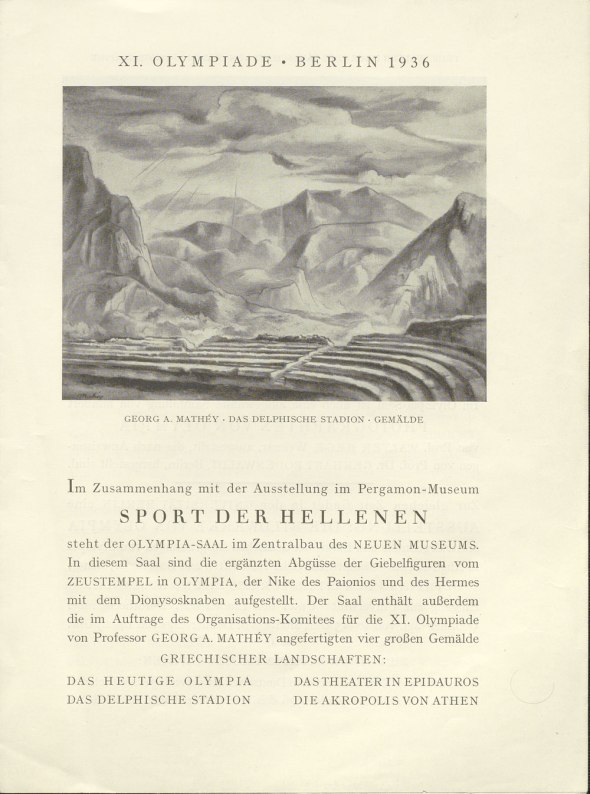
Special importance was attached to a plaster-cast model of Olympia by the architect Hans Schleif. It was presented in the anteroom of the exhibition and was originally intended to be framed by Mathéy’s pictures of Greece. Shortly before the opening of the exhibition, those responsible – Theodor Lewald, Theodor Wiegand and Carl Blümel – rejected this plan. To Mathéy’s great displeasure, his paintings were moved to another part of the Museum Island (Axtmann – Stello 2017, 101).
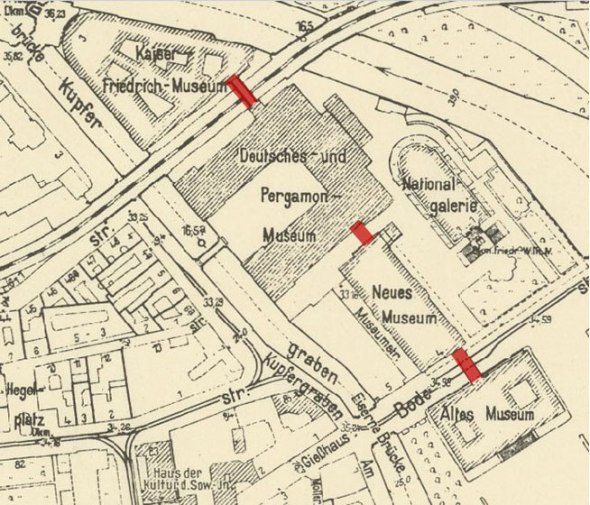
HistoMapBerlin (Map series KA, map sheet 4232, edition 1940).
The second part of the exhibition was held in the Neues Museum, which could be reached via an above-ground connecting passage from the Pergamon Museum (for the connecting corridors, see the YouTube film by Katrin und Hans Georg Hiller von Gaertringen, starting at 20:30). The corresponding exhibition space was renamed the “Olympia Hall” at short notice. Mathéy’s paintings with scenes from the Acropolis, Delphi, Epidauros and Olympia were presented together with other items in the skylight gallery of the Egyptian Court in the Neues Museum. Mathéy described the room as a “gloomy box that makes any contemplation impossible” (BLB, Nachlass Georg Alexander Mathéy, K 3328 C 71 7). Previously inaccessible, the room had served for storage of plaster casts from Olympia since the 1920s.
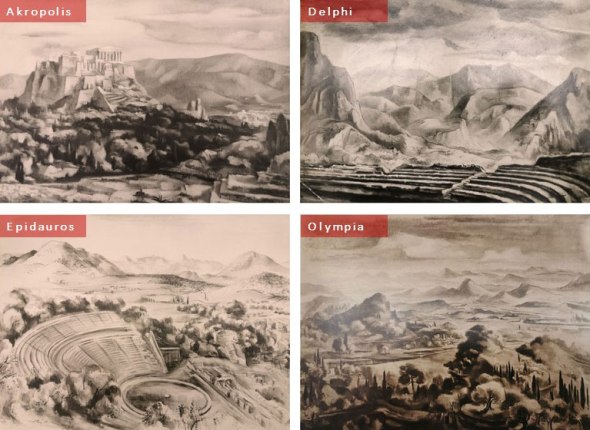
About a hundred shots of Olympia by the photographer Walter Hege (1893-1955) were also exhibited in the same room, again to Matthey’s dissatisfaction. His correspondence reveals that he did not particularly appreciate Hege’s work, although a deeper conflict between the media of “painting” and “photography” may have been the underlying cause. In any case, Hege was courted by sports officials and art scholars during the Olympics in a way that certainly aroused envy among his colleagues. “The guy makes a fuss about his photos as if there were no other photographer in the world” Matthey scribbled in his diary (BLB, Nachlass Georg Alexander Mathéy, K 3328 A 42,1 and K 3328 D 38,87; December 4, 1935).
Unfortunately, there is no documentation for this part of the exhibition. Only a few photos show the plaster casts of the Temple of Zeus in Olympia, which had already been placed in the skylight gallery of the Egyptian Court before 1936 (Berger 2018, 90-93). On the basis of Mathéy’s correspondence and several newspaper articles, however, it is possible to reconstruct how Mathéy’s pictures and Hege’s photographs were presented to visitors: Mathéy’s pictures were hung on the narrow sides of the room and Hege’s photographs were attached to the “superstructure in the middle gallery,” i.e., presumably on the balustrade of the skylight gallery (BLB, Nachlass Georg Alexander Mathéy, K 3328 C 71 20).
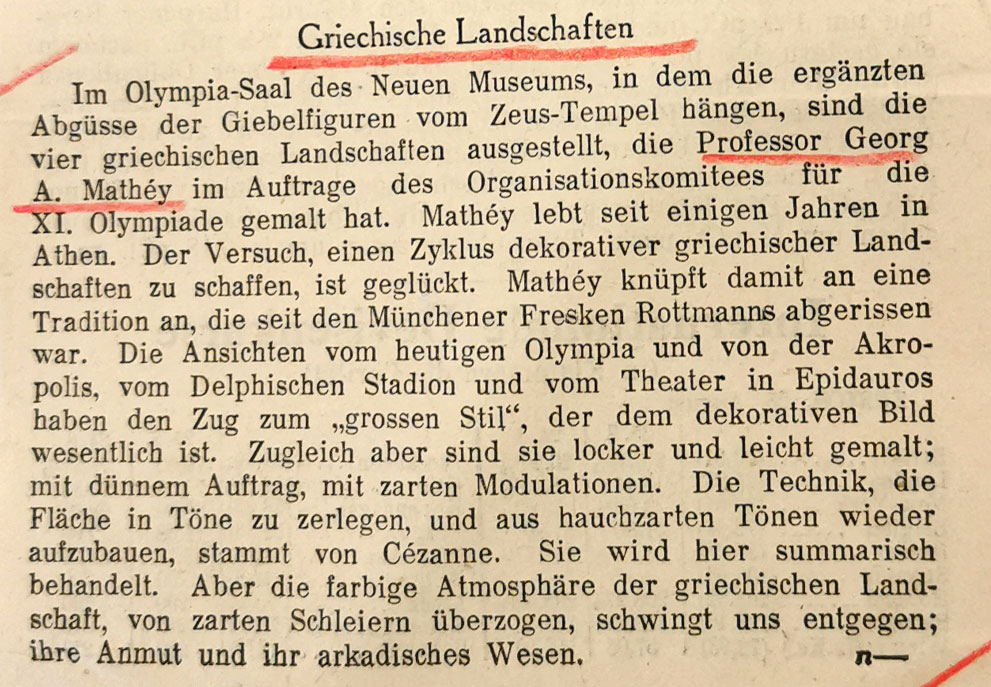
Source: BLB, Nachlass Georg Alexander Mathéy, K 3328 A 95,42
Greek Landscapes
In the Olympia Hall of the New Museum, where the completed casts of the pediment figures of the Temple of Zeus hang, are exhibited the four Greek landscapes painted by Professor A. Mathéy on behalf of the Organizing Committee for the XI Olympic Games. Mathéy has lived in Athens for several years. The attempt to create a cycle of decorative Greek landscapes was successful. Mathéy continues a tradition that had been torn off since Rottmann’s Munich frescoes. The views of the present-day Olympia and the Acropolis, the Delphic Stadium, and the theater at Epidauros have the “grand manner” trait essential to decorative painting. At the same time, however, they are painted loosely and lightly, with thin application, with delicate modulations. The technique of breaking the surface into shades and rebuilding it from delicate tones comes from Cézanne. It is treated summarily here. But the colorful atmosphere of the Greek landscape, covered with delicate veils, echoes in us, its grace and Arcadian character.
The impact of Olympic participation: Later success in Greece and Germany.
Although Mathéy strongly resented the banishment of his paintings from the German Museum in the north wing of the Pergamon Museum, he subsequently received great recognition both in Germany and in Greece. Two of his works – “The Acropolis of Athens” and “The Delphic Stadium” – were bought by the Reich Aviation Ministry in Berlin in 1936.
At the end of 1936, the German-Greek Society in Athens organized a special exhibition for Mathéy, presenting his works in Greece. It was very well received both by experts and interested laymen and was even visited by King George II. Reviews in German and Greek newspapers testify to his great success. On February, 4 1937, Mathéy was awarded the Silver Cross of the Order of St. George: “H.M. King George II of Greece has awarded the German painter Prof. Georg A. Mathéy, artistic collaborator at the 1936 Olympic Games in Berlin, the Silver Cross of the Order of St. George in recognition of his services to German-Greek cultural cooperation. As is well known, Prof. Mathéy created four large paintings of Greek landscapes for the Olympic exhibition, two of which have since been purchased by the Reich Aviation Ministry.” (Extract from the newspaper Neue Athener Zeitung, February 6, 1937, BLB Nachlass Georg Alexander Mathéy, K 3328 D 38,32).

Eventually and inevitably Mathéy’s fame reached the leading circles of the Nazi state. In 1942 Albert Speer, Reich Minister for Armament and Ammunition, commissioned Mathéy to produce three more paintings with views of Greece. “I am working for Professor Speer on three large Greek landscapes, which will later be used to decorate public buildings,” wrote Mathéy to archaeologist Peter Goessler on October 19, 1942 (Wuppertal Municipal Archives, Nachlass Wilhelm Dörpfeld, NDS 23 No. 16).
Whether Mathéy carried out this commission is uncertain. In addition, his four paintings for the exhibition “Art of the Hellenes” were most likely destroyed during the bombing of Berlin: “How sad that all your beautiful works in Berlin have been destroyed” wrote Lewald to Mathéy on December 25, 1944 (BLB, Nachlass Georg Alexander Mathéy, K 3328 B 545 2). World War II ended the Greek chapter in Mathéy’s life and work. Divorced from Polyxene, he would marry again in 1945 and make a new start in Germany. He continued to visit Greece (and his son Alexander) as his museum pass from 1961 shows. Polyxene Mathéy (a cousin of Greek dancer, Koula Pratsika), an enlightened woman, made a career in Greece both as a music teacher and a choreographer, founding her own dance school and participating with her students in various performances of ancient drama.
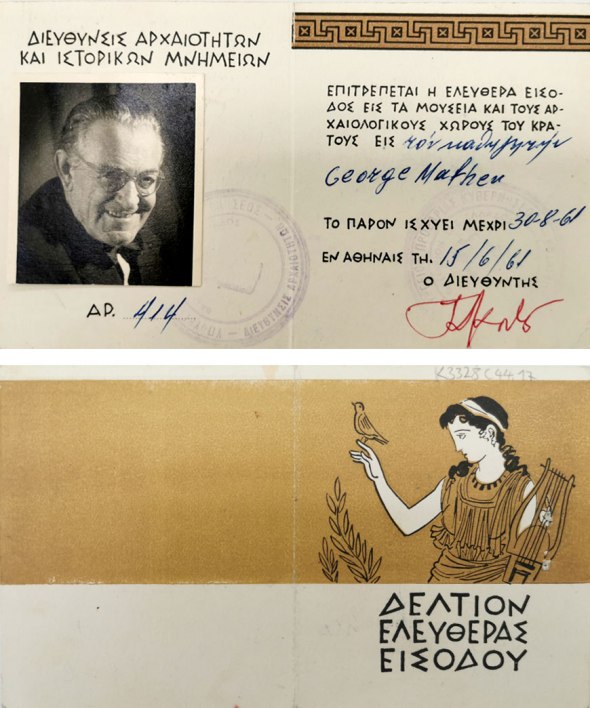
Although Georg Alexander Mathéy is nearly forgotten today, he left behind works characteristic of his time, such as his stamp designs in Germany and the mosaic for the German Protestant Church in Athens. These invite reflection and further investigation by modern scholars. The fact that Mathéy and many other European artists, such as the ones mentioned above (Alexander Mohr, Conrad Westpfahl, Herbert List and Hermann Wagner) but also the likes of Piet de Jong and Georg von Peschke, chose to move to Athens in the 1930s, it is indicative of the city’s intellectual life that embraced modernism and avant-garde culture.
REFERENCES
Axtmann A. and A. Stello (eds.) 2017. Sprachbilder – Bildersprache: Die Künstler Helene Marcarover und Georg Alexander Mathéy. Begleitpublikation zur Ausstellung in der Badischen Landesbibliothek Karlsruhe vom 12. Juli 2017 bis 30. September 2017, Karlsruhe.
Berger, F. 2018. “Apollon und Zeus in Berlin. Zur Aufstellungsgeschichte der Giebelgruppen vom olympischen Zeustempel,” in: M. Maischberger and B. Feller (eds.), Außenräume in Innenräumen. Die musealen Raumkonzeptionen von Walter Andrae und Theodor Wiegand im Pergamonmuseum, Berlin 2018, 75-102
Blümel, C. 1936. Sport der Hellenen, Berlin
Führer zur Feier der XI. Olympiade Berlin 1936. Herausgegeben vom Organisationskomitee für die XI. Olympiade Berlin 1936, Berlin 1936: digital copy
Hege, W. and G. Rodenwaldt, 1936. Olympia, Berlin.
Lehmann, S. 2003. ” ‘Sport der Hellenen’ – Die Berliner Ausstellung von 1936 und der jüdische Archäologe Alfred Schiff (1863-1939),” in: A. Höfer, M. Lämmer and K. Lennartz (eds.), Olympische Spiele. Olympic Games. Jeux Olympiques, special edition of the journal Stadion: Internationale Zeitschrift für Geschichte des Sports 29, 2003, 199-220.
Moraitou, G. 2020. Othon Rousopoulos and the Early History of Archaeological Conservation in Greece, Athens.
Oppeln-Bronikowski, F. 1935/36. “Die Olympia-Ausstellung ‘Sport der Hellenen’ im Deutschen Museum, Berlin,” in: Die Kunst für alle: Malerei, Plastik, Graphik, Architektur 51/12, 284-288 : digital copy
Reyle, R. 1933. Der Maler Georg Alexander Mathéy (Athens 1933) : digital copy


Help
It won’t open and says I have to go to the site with a password? When I get there, the article is not there and nothing about a password. What gives?
Hope all is well and stay cool, Ludmila
Sent from my T-Mobile 5G Device
Ludmila, I had some technical problems but it is out (no need for password). Go to: https://nataliavogeikoff.com/2022/08/02/the-forgotten-olympic-exhibition-georg-alexander-matheys-contribution-to-the-1936-summer-olympics-in-berlin/
Natalia, I got it open on my computer with no problem. Another great article as usual!